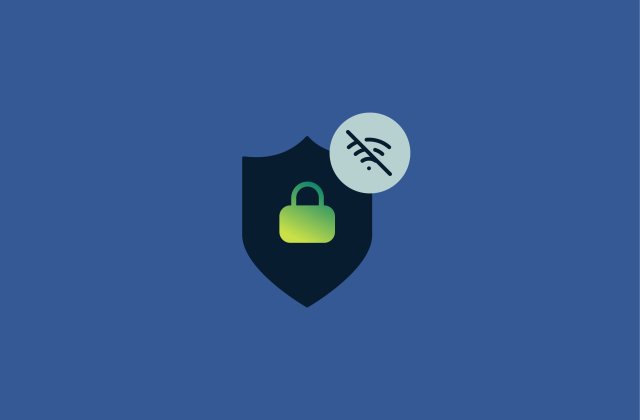What is TLS encryption, and how does it protect your data?

Transport Layer Security (TLS) is the most widely used method for protecting data as it moves between devices and services. It powers HTTPS for secure websites, encrypts many email and messaging connections, and protects app data in transit even over public or untrusted networks.
In this guide, you’ll learn what TLS is, how it works, the security benefits it provides, and how it’s used in everything from web browsing to virtual private networks (VPNs). You’ll also learn about the differences between TLS and Secure Sockets Layer (SSL), the risks to watch for, and the steps to configure TLS securely.
What is TLS encryption?
TLS is a security protocol that protects information while it travels over a network. It does this by adding three key safeguards:
- Confidentiality: Outsiders can’t read the data while it’s in transit.
- Integrity: Any change to the data en route can be detected.
- Authentication: You can be sure you’re connected to the intended service and not an impostor.
Note that TLS doesn’t protect how a site stores data or what the site does with it after decryption.
When you connect to a secure service, TLS starts by having the server prove its identity using a digital certificate. This certificate is issued by a trusted authority known as a certificate authority (CA), which is an organization that verifies domain ownership and signs the certificate so browsers, operating systems, and other clients can trust it automatically.
Once that identity is verified, TLS and the other party agree on unique, session-specific encryption keys. These keys are then used to protect all further communication. TLS also protects application data with authenticated encryption (AEAD), which ensures that the data is kept secret and that any tampering is detected.
TLS is used in many contexts: securing websites, encrypting emails between mail servers, protecting chat services, securing database connections, and enabling private remote access. The protocol has evolved over the years, replacing older, weaker designs with stronger algorithms and simpler, safer configuration options.
What is the difference between TLS and SSL?
Secure Sockets Layer (SSL) was the earlier protocol that TLS replaced. SSL is now considered unsafe due to both cryptographic weaknesses, such as reliance on outdated algorithms like Rivest Cipher 4 (RC4) and Secure Hash Algorithm 1 (SHA-1), and inherent design flaws. These issues made it possible for attackers to intercept and read traffic if they could position themselves between the user and the server in a man-in-the-middle (MITM) attack.
TLS addressed these flaws, but its first versions (1.0 and 1.1) still permitted outdated ciphers and lacked modern safeguards, so they’re now deprecated. Today, it’s best to use TLS 1.3 by default and keep TLS 1.2 only when needed and configured to use strong, up-to-date cipher suites.
Is TLS still secure?
Yes, when it’s configured and maintained properly.
The U.S. government and major industry standards now treat TLS 1.3 as the benchmark for secure communication. TLS 1.2 is still acceptable in some situations, but only when paired with strong cipher suites and secure key exchange methods. Leaving outdated options enabled gives attackers an opening to weaken or bypass the encryption, which is why regular updates and proper configuration are critical.
How does TLS encryption work?
A TLS session has two phases. First, the server proves its identity, and the two parties (such as a browser and a web server) agree on new encryption keys. Then, every message they exchange is encrypted and checked for tampering. This mix of identity checks and encryption is what keeps TLS both secure and fast in real-world use.

The TLS handshake explained
The handshake is the brief setup that upgrades an ordinary connection to a secure one. It starts when the client states which TLS version it can use and lists its supported cipher suites, key exchange methods, and relevant options, such as signature algorithms and supported groups.
The server picks from those, sends back its choice, and provides a chain of certificates proving that its public key belongs to the domain name in use. Both sides then run a key exchange to create fresh, temporary keys for this session only.
With TLS 1.3, the handshake usually completes in one round trip. A client that has connected recently can resume a session and send zero round-trip time (0-RTT) early data: information sent before the handshake is finished to speed up loading. Because early data isn’t forward secure, it should only be allowed for idempotent reads (requests that have the same effect no matter how many times they’re repeated).
Role of symmetric and asymmetric encryption
TLS uses asymmetric cryptography during its initial handshake. The server proves its identity by presenting a digital certificate containing its public key, which the client verifies using a trusted CA. The client and server then use these public/private key pairs to securely exchange or negotiate a shared secret without ever sending the secret itself across the network.
Once the key exchange is complete, TLS switches to symmetric encryption, which uses the same key for both encrypting and decrypting. This is far quicker and better suited for high-volume data transfer.
How cryptographic keys are exchanged securely
Old TLS setups sometimes used static RSA or static Diffie–Hellman (DH) key exchange, which reused keys over time. TLS 1.3 removed them. In TLS 1.3, all standard key exchanges now use short-lived, per-session keys.
This offers forward secrecy, meaning that even if someone records your traffic today and steals the server’s private key years later, they won’t be able to read the old data.
What is a TLS certificate, and how is it verified?
A TLS certificate is a signed document linking a public key to a domain name. The server sends a chain of these during the handshake. The client checks that:
- The chain ends with a certificate from a trusted CA that the browser, operating system, or app already recognizes.
- The certificate is within its validity period, not revoked, and allowed for the intended use (e.g., server authentication).
- The name on the certificate matches the domain being visited (checked via the Subject Alternative Name field).
Benefits of the TLS protocol
- Confidentiality: Encryption keeps your connection private from anyone else on the network.
- Integrity: Built-in checks detect any change to data in transit.
- Authentication: Certificates prove the server is the real site; some setups also verify the client.
- Forward secrecy: Past sessions stay safe, even if long-term keys are later stolen.
- Efficiency: TLS 1.3 can establish a secure connection in a single round trip.
- Compatibility: Works with all major browsers, operating systems, and most network devices.
Known risks and mitigations
Even a well-configured TLS setup can be undermined by outdated settings or weak operational practices. Understanding the main risks and how to mitigate them helps you keep encryption effective and avoid common pitfalls.
- Outdated versions or weak algorithms: Using TLS 1.0, TLS 1.1, or insecure ciphers makes encrypted traffic vulnerable to known attacks. To avoid this, disable obsolete protocol versions and configure TLS 1.2 or higher with secure cipher suites as outlined in TLS configuration best practices.
- Certificate misissuance: A compromised or careless CA could issue a valid-looking certificate for your domain. Monitor Certificate Transparency logs for your domains and investigate any unexpected certificates immediately.
- Weak revocation checks: If a certificate is revoked but the status isn’t checked promptly, users could still connect to a server you no longer control. Revocation information is usually delivered via the Online Certificate Status Protocol (OCSP), where the client asks the CA whether a certificate is still valid. To improve speed and reliability, enable OCSP stapling, which lets the server send a recent OCSP response directly during the handshake.
- Replay of early data: TLS 1.3’s 0-RTT early data can be replayed by an attacker to repeat certain requests. Allow early data only for idempotent reads, and delay any state-changing actions until the handshake is complete.
TLS vs. HTTPS: What’s the relationship?
TLS and HTTPS are closely related, but they’re not the same thing. TLS is the underlying protocol that encrypts data in transit, ensures integrity, and authenticates servers (and optionally clients). HTTPS is simply HTTP running over TLS; the “S” at the end of the URL indicates that the connection is secured by TLS.
When you visit an HTTPS website, TLS handles the handshake, certificate verification, and encryption, while HTTP defines how the browser and server request and deliver content. Without TLS, HTTP traffic is transmitted in plain text, leaving it vulnerable to eavesdropping and tampering.
Basically, TLS is the security layer, and HTTPS is the application of that security to the web.
Does HTTPS use SSL or TLS?
Modern HTTPS uses TLS. SSL is an older encryption protocol and is no longer considered secure; it should not be used by either servers or browsers. Note that you might still hear the term “SSL certificate,” but today these certificates are used to enable TLS, not SSL.
The role of TLS in web encryption
TLS is the layer that keeps web traffic private and authentic. It protects everything sent between the browser and the site, including cookies that maintain your login, form entries, and any background requests made by a site or app.
Newer web technologies continue to rely on TLS for security. For example, HTTP/3, the newest version of the web’s main protocol, encrypts all traffic using TLS 1.3 while also making connections faster and more reliable, even on slower or unstable networks.
TLS 1.2 vs. TLS 1.3: What’s changed?
TLS 1.3 is the latest version of the TLS protocol, building on the foundation of TLS 1.2. While both versions protect your connections, TLS 1.3 simplifies the handshake, removes outdated features, and improves performance and security.
Key improvements in TLS 1.3
TLS 1.3 improves security and speed by only supporting modern encryption methods, like Advanced Encryption Standard in Galois/Counter Mode (AES-GCM) and ChaCha20-Poly1305. It also strengthens key generation so that session keys are unique and protected against tampering or downgrade attacks.
TLS 1.3 also removes older features, like static RSA key exchange and renegotiation, which simplifies connections and reduces potential vulnerabilities.
Backward compatibility with older protocols

Most setups offer both TLS 1.3 and TLS 1.2, with TLS 1.3 used by default. TLS 1.0 and 1.1 are no longer fit for purpose and should be disabled completely. Keep TLS 1.2 only when it uses Elliptic Curve Diffie–Hellman Ephemeral (ECDHE) key exchange (X25519 or P-256) and AEAD suites; this maintains compatibility without reducing security for current systems.
TLS encryption in the real world
TLS protects far more than just web browsing. Here are some of the common applications:
Websites, APIs, and email
HTTPS uses TLS to encrypt and authenticate web traffic, protecting both websites and APIs. Many apps also rely on TLS to secure data exchanged between devices and servers.
Email servers can switch from an unencrypted link to an encrypted one with a feature called Start Transport Layer Security (STARTTLS). This upgrades the connection so messages are encrypted while moving between servers. By default, STARTTLS is opportunistic, meaning that if the encryption setup fails, the message may still be sent in clear text.
To make encryption in transit mandatory, services can use Mail Transfer Agent Strict Transport Security (MTA-STS), a published policy telling other mail servers to deliver mail only if TLS encryption is available, or DNS-based Authentication of Named Entities (DANE), a Domain Name System (DNS) record that lists the correct TLS certificate details for the domain. These prevent delivery if a secure connection can’t be made.
VPNs and remote access
TLS is commonly used in remote access setups and VPN services because it can pass through most firewalls and network filters without special configuration. In these systems, TLS first authenticates the server (and sometimes the client) using certificates, then establishes encryption keys.
Once the secure setup is complete, all user traffic is sent through this protected channel, keeping it private from anyone on the network.
ExpressVPN’s Lightway protocol, for example, uses Datagram Transport Layer Security (DTLS) 1.3, a version of TLS 1.3 adapted for User Datagram Protocol (UDP). This allows encrypted, low-latency connections while taking advantage of UDP’s speed and flexibility.
Mobile and app security
Mobile and desktop apps typically use TLS to connect to their servers, especially when running on public Wi-Fi or other untrusted networks. Strict certificate checks are essential to ensure the app is talking to the correct server. TLS 1.3 is preferred for new deployments because it establishes connections faster and enforces stronger defaults, including AEAD ciphers and ephemeral key exchanges for improved security.

How to implement TLS encryption on your website
A secure TLS setup relies on more than simply enabling HTTPS. It requires a valid certificate, modern protocol versions, strong encryption settings, and ongoing maintenance. The objective is to make the secure connection the default while closing off weak paths that attackers could use.
Choosing and installing a TLS certificate
The first step is selecting a certificate that matches your domain setup. A single-name certificate secures one domain (for example, example.com). A wildcard certificate secures the main domain and all subdomains one level below it (like blog.example.com or shop.example.com).
A multi-domain certificate can cover several unrelated domains. All three offer the same encryption strength; the difference is only in coverage and how the CA verifies your control over each name.
Automating certificate issuance and renewal prevents expired certificates from disrupting service. When installing a certificate, include the full chain (your certificate plus any intermediate CA certificates), so browsers can build a complete trust path to a known root.
It’s also wise to monitor Certificate Transparency logs, which are public records of issued certificates, to detect any that have been issued for your domains without your authorization. Planning ahead for domain ownership changes, server retirements, or emergencies ensures a certificate issue doesn’t turn into extended downtime.
TLS configuration best practices
Once you have the certificate, the next step is configuring TLS correctly. Here, clarity matters more than complexity.
- Offer TLS 1.3 and TLS 1.2, removing TLS 1.0 and 1.1 entirely.
- For TLS 1.2, use ECDHE key exchange (X25519 or P-256) and AEAD suites such as AES-GCM or ChaCha20-Poly1305.
- Prefer AEAD suites. Where legacy clients aren’t required, remove Cipher Block Chaining (CBC) suites and always remove RC4 and SHA-1, as they’re outdated and unsafe.
- Set HTTP Strict Transport Security (HSTS) to force HTTPS connections. Add subdomains only when all are HTTPS-ready.
- Enable OCSP stapling and keep the stapled response fresh. Where possible, enable OCSP Must-Staple.
- If you enable early data (information sent before the handshake finishes), allow it only for safe, read-only actions.
- Avoid private CAs unless you control every connecting device and can manage renewals and emergencies.
- If you pin certificates in an app, keep backup keys and test your recovery plan to prevent accidental lockouts.
Testing and maintaining TLS security

TLS security requires ongoing attention. After any change to your server, load balancer, or application settings, scan the configuration to confirm that only the intended protocol versions and cipher suites are active and that all required security headers are present.
Include TLS library and web server updates in your regular maintenance to address any security issues reported for your TLS implementation or server software.
You should also stay up-to-date on changes to browser trust stores and CA policies, as these can affect whether your certificates are accepted. Keep detailed logs of failed handshakes and certificate errors so you can investigate problems that users might not report.
Finally, make sure your procedures for certificate renewal, replacement, and incident response are documented and tested so you can apply fixes quickly without introducing new issues.
FAQ: Common questions about about TLS encryption
What is TLS encryption?
Transport Layer Security (TLS) encryption is a method for securing data while it’s being sent over a network. It does this by verifying identities, encrypting traffic, and detecting tampering before the data reaches its destination.
Is TLS better than SSL?
Yes. Secure Sockets Layer (SSL) is an outdated protocol with known vulnerabilities, while Transport Layer Security (TLS) is its modern replacement with stronger encryption and better security features.
Can TLS encryption be hacked?
Breaking Transport Layer Security (TLS) directly is impractical with current technology. Attacks usually target weak configurations, outdated versions, or the systems around TLS rather than the protocol itself.
What happens if a TLS certificate expires?
Browsers will warn users and may block access to the site. An expired certificate means the site’s identity can’t be trusted until the certificate is renewed.
Take the first step to protect yourself online. Try ExpressVPN risk-free.
Get ExpressVPN



















